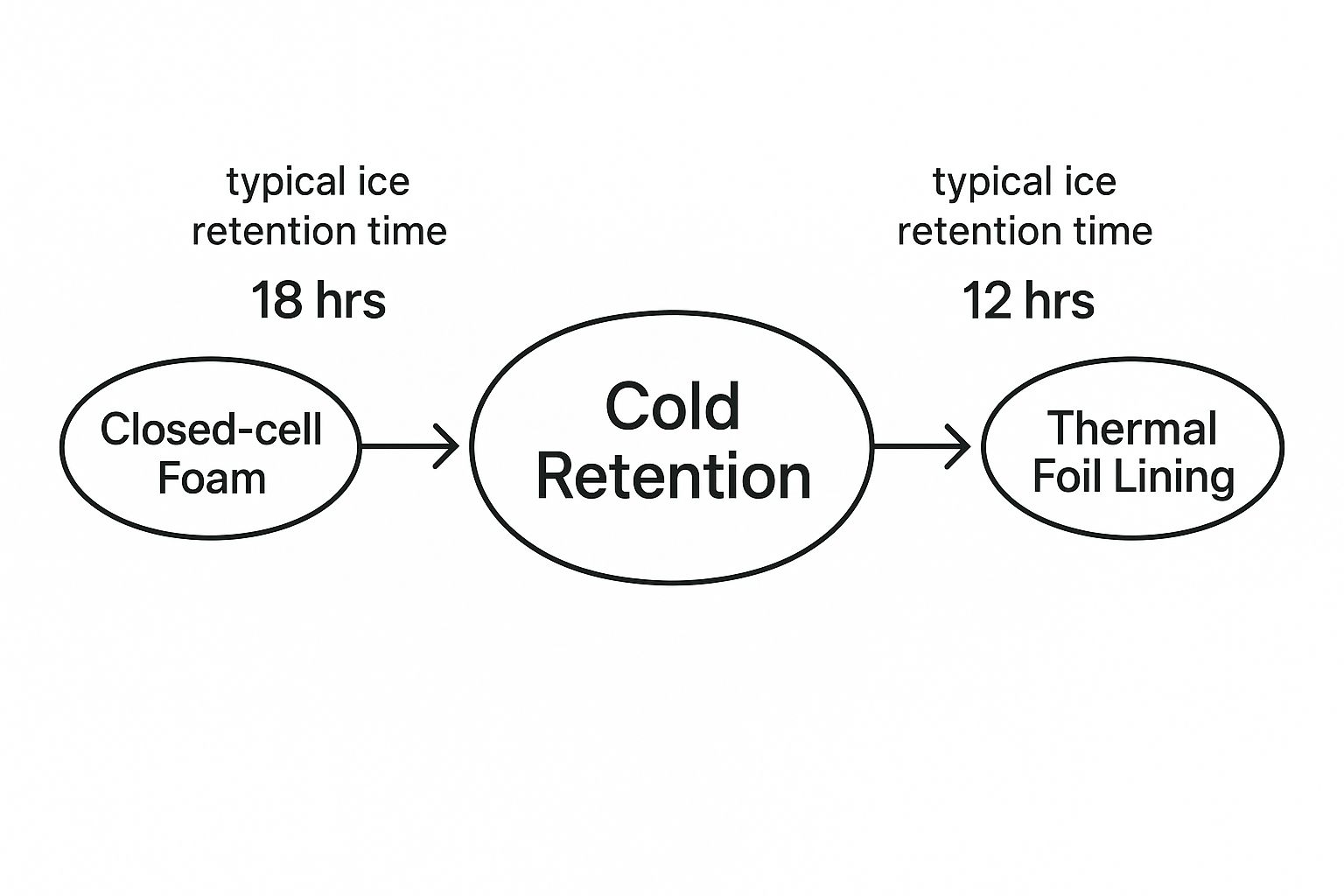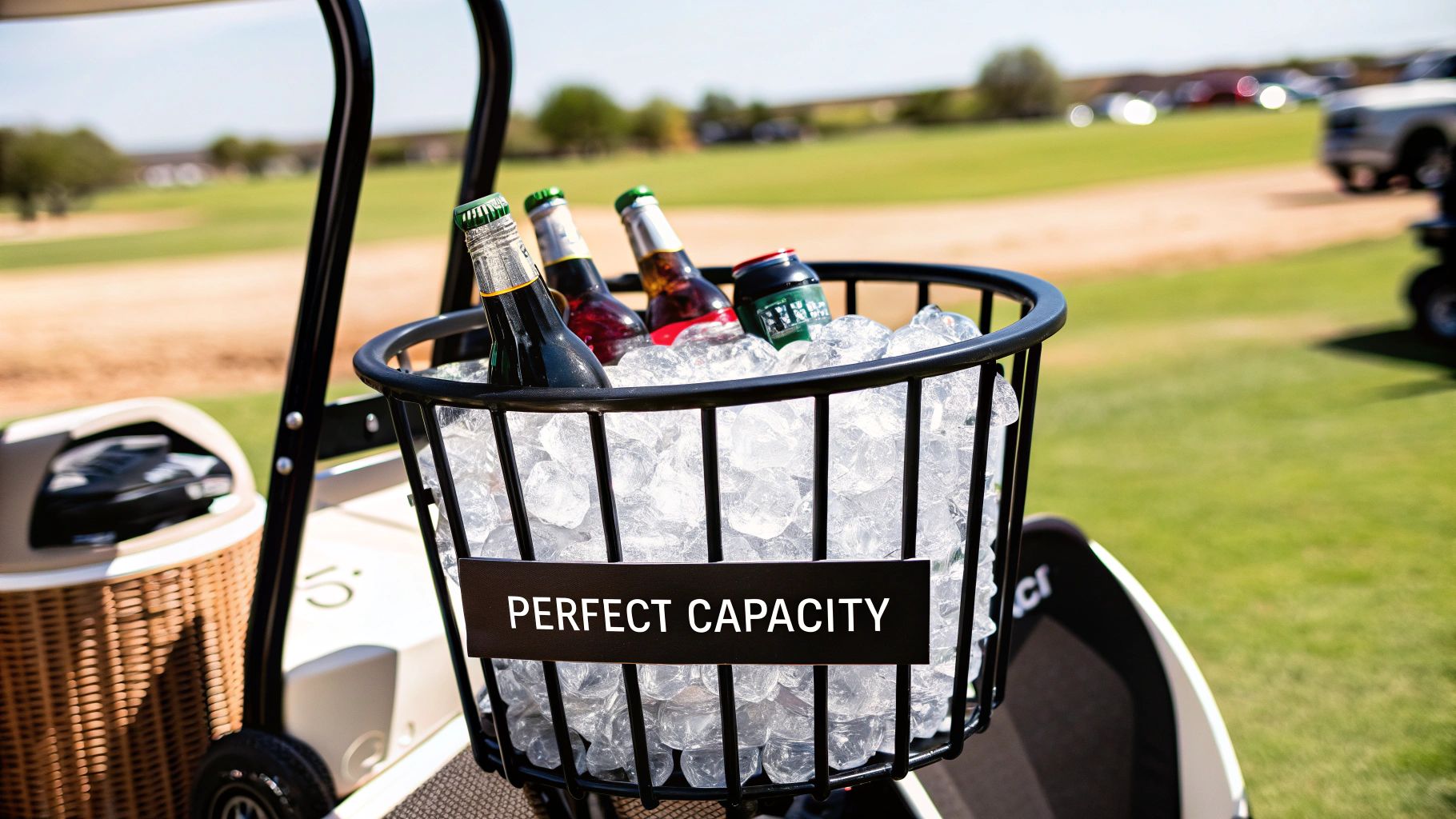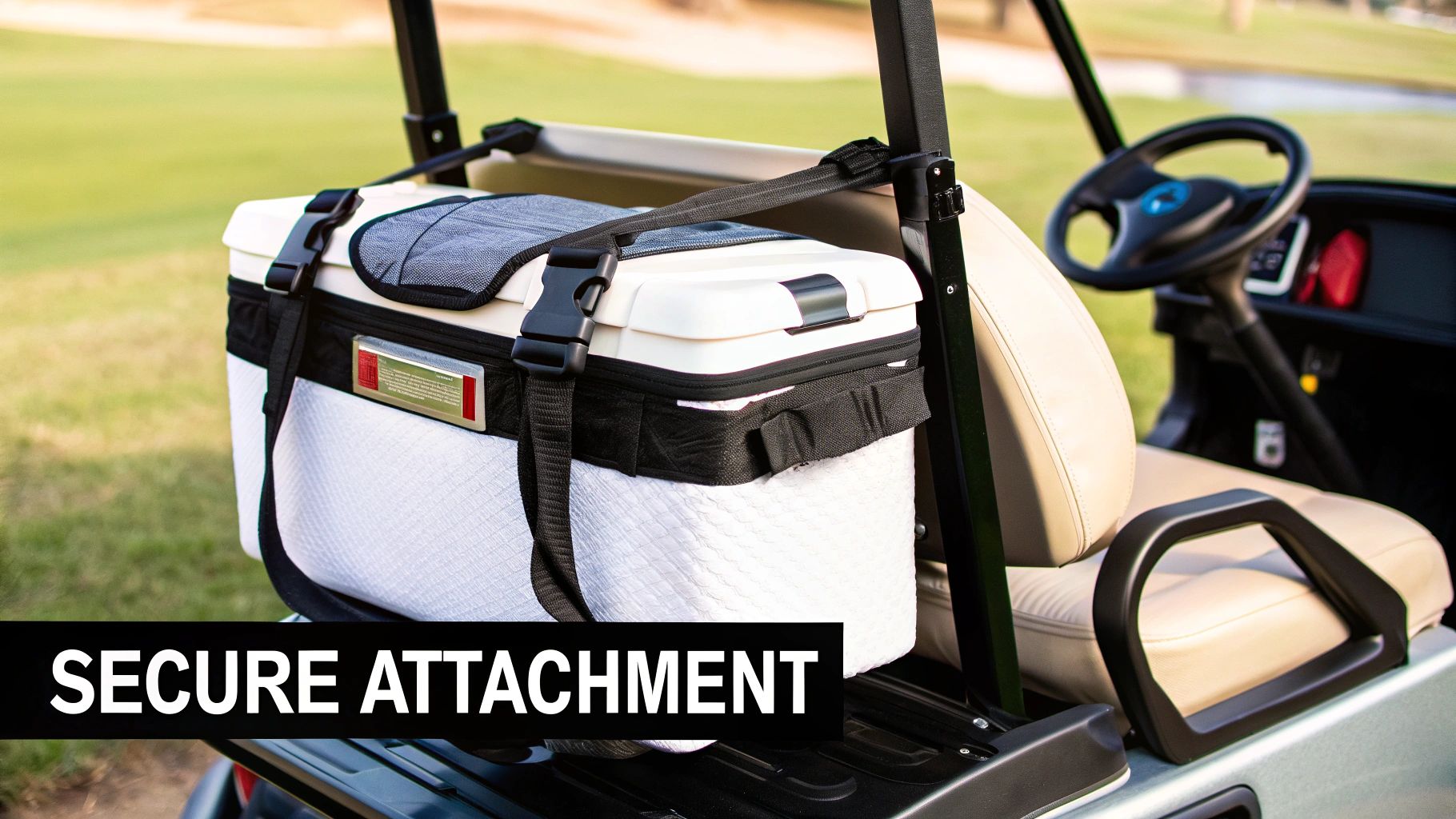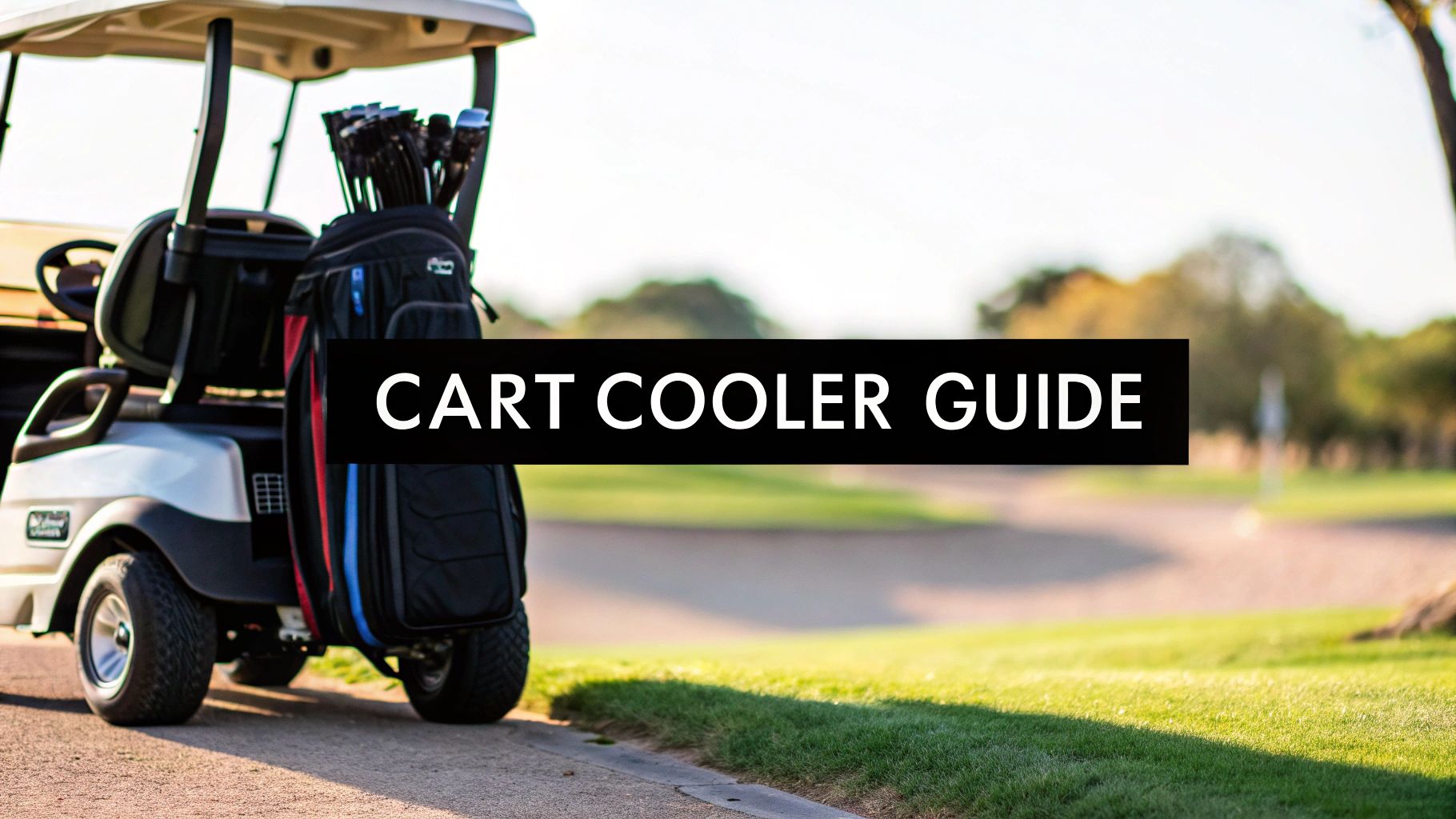There's nothing worse than staring down a long fairway on a hot day, knowing the drink in your bag is probably lukewarm. A quality golf cart cooler bag isn't just a luxury—it's a critical piece of gear that keeps you hydrated and focused from the first tee to the eighteenth green. No more annoying trips back to the clubhouse.
Keeping Your Cool on the Course
When the sun is beating down, your energy can drain surprisingly fast. That's when a dedicated cooler bag becomes more than just a convenience; it becomes a strategic part of your equipment. It’s all about helping you maintain peak physical and mental performance by keeping you properly fueled and hydrated throughout your round.
This goes way beyond just avoiding a warm sports drink. Think of it as game management. Having ice-cold water and a few snacks ready to go keeps your energy levels stable, helping you sidestep the kind of fatigue that leads to sloppy swings and costly mistakes on the back nine.
Why Every Golfer Needs One
The benefits of adding a dedicated cooler to your setup are pretty clear once you think about it:
- Sustained Performance: Consistent access to cold drinks is key to regulating your body temperature and fighting off dehydration before it starts.
- Uninterrupted Play: Forget waiting for the beverage cart or pausing your game. Keep your momentum going and stay in the zone.
- Convenience and Organization: Modern cooler bags are designed for easy access and secure attachment, so your refreshments are always within arm’s reach but never in the way of your clubs.
It's no surprise these accessories are booming in popularity. The market for golf cart cooler bags was valued at a cool $215 million and is expected to nearly double to $420 million by 2033. That’s a powerful testament to how many golfers now see them as essential.

This guide will walk you through everything you need to know, from the different types of insulation to capacity and mounting systems. And for those who enjoy taking their refreshments on other outdoor adventures, exploring some essential picnic accessories can give you even more ideas for portable cooling. By understanding the fundamentals, you’ll be able to pick the perfect cooler bag to up your game.
How Cooler Bag Insulation Really Works
Not all golf cart cooler bags are created equal. The real secret weapon separating an all-day performer from a dud that’s lukewarm by the 4th hole is its insulation.
Think of insulation as a dedicated bodyguard for your cold drinks. Its only job is to stop heat from sneaking in and ruining the party. The science is pretty straightforward—insulation works by slowing down heat transfer. In a cooler, this means creating a barrier that stops the warm outside air from reaching the chilled cans inside. The best bags pull this off using specialized materials designed to trap cold and repel heat.
The Two Key Materials
Most effective cooler bags rely on a one-two punch of materials working in tandem. Once you know what they are, you’ll see why some bags keep ice for hours while others just can't hang.
The primary players are:
- Closed-Cell Foam: This is the absolute workhorse of cooler insulation. It’s filled with tons of tiny, trapped gas bubbles that aren’t connected to each other. Because heat has a tough time moving through these little pockets, closed-cell foam is incredibly effective at stopping it cold, creating a powerful thermal barrier.
- Thermal Foil Linings: This is the shiny stuff you often see on the inside of a cooler. It works on a totally different principle called thermal radiation. It literally reflects heat waves away from your drinks, just like one of those reflective sunshades for a car windshield keeps the interior from baking in the sun.
This infographic breaks down how these two materials team up to maximize cold retention in a quality golf cart cooler bag.

As you can see, while both are critical, it's the closed-cell foam that provides the heavy-duty foundation for long-lasting cold.
How Insulation Thickness Makes a Difference
It’s just like a winter coat—a thicker one keeps you warmer. The same logic applies here: thicker insulation provides way better cooling performance. A cooler bag with a half-inch or more of high-density closed-cell foam will dramatically outperform one with a thin, flimsy layer. It’s all about creating a more substantial wall against the outside heat.
This means a well-insulated bag doesn't just start cold; it stays cold. It can easily keep ice solid through a four-hour round on a scorching summer afternoon. When you're shopping, pay close attention to the thickness and density of the foam. It’s the single most important factor for all-day performance.
The best golf cart cooler bags combine thick closed-cell foam for conductive heat resistance with a thermal foil liner to reflect radiant heat. This dual-layer approach ensures maximum efficiency, keeping your refreshments perfectly chilled from the first tee to the last putt.
Choosing the Right Cooler Size and Capacity

Picking the right size for your golf cart cooler is a classic balancing act. It’s easy to think bigger is always better, but don't get fooled by the listed can count. That "12-can cooler" you're eyeing almost never holds 12 cans plus the ice you'll need to keep them cold for a full 18 holes.
Think of the manufacturer's can count as the absolute, stuffed-to-the-gills maximum. In the real world, you need space for ice or freezer packs, which can easily eat up 25-40% of the interior. That 12-can cooler? It's really more like a six-to-eight can cooler once you add ice and maybe a sandwich.
Matching Capacity to Your Golfing Style
The perfect size really boils down to how you spend your day on the course. A solo golfer out for a quick nine has completely different needs than a foursome battling it out in an all-day tournament. It’s the age-old trade-off: capacity versus portability.
To find your sweet spot, think about who you usually play with:
- The Solo Golfer (6-9 Can Capacity): A compact cooler is your best friend. It’s just enough for a few drinks and a snack without adding annoying bulk, and it'll slide right into any cart basket.
- A Pair of Golfers (12-18 Can Capacity): This is the sweet spot and the most popular size for a reason. It gives you plenty of room for drinks and lunch for two, striking that perfect balance between space and convenience.
- A Full Foursome (24+ Can Capacity): When you're the designated beverage captain for the group, you'll need a bigger bag. These can handle enough for everyone, but be warned—they take up some serious real estate on the cart.
Here's the golden rule to remember: Capacity minus ice equals reality. Always factor in the space your ice packs will take up. Overstuffing a cooler kills the airflow, making the insulation way less effective and leading to that sad moment when you pull out a warm drink on the back nine.
Portability and Fit on the Cart
Finally, think about where this cooler is going to live. Will it sit in the basket? Strap to a fender? Hang from the frame? An oversized cooler that blocks access to your clubs or other gear will become a frustration you'll regret every single round.
Before you click "buy," go measure the available space on your cart. A cooler that fits perfectly is a cooler you'll actually use. Of course, some golfers skip the separate bag altogether and opt for a main golf bag with a cooler built right in. If that sounds like you, you can learn more about finding the right golf bag with an integrated cooler here.
Ultimately, the best cooler is the one that meets your needs without ever getting in your way.
Securely Attaching a Cooler to Your Cart

A perfectly chilled drink is worthless if it ends up spilled all over the fairway. It’s a simple truth, but the way a cooler attaches to your cart is just as important as how well it insulates—yet it's a feature most people overlook until it's too late. A wobbly, sliding cooler isn't just annoying; it's a recipe for a ruined day on the course.
The goal is simple: find a mounting system that locks your cooler down, no matter how bumpy the cart path gets. Modern golf cart cooler bags have some clever attachment methods, each with its own set of pros and cons. Understanding these options will help you make your cooler a seamless part of your setup, not a liability.
Common Cooler Attachment Styles
Most designs boil down to two main approaches: universal flexibility or a custom, drop-in fit. Let’s break down what you’ll typically find.
1. Strap-On and Buckle Systems
This is the workhorse of cooler attachments. These bags use adjustable straps—usually with heavy-duty Velcro or rugged plastic buckles—to latch onto various points on your cart. Think front fenders, roof supports, or the rear frame.
- Pros: They’re incredibly adaptable. You can fit these bags on almost any cart model and position them where they won’t interfere with your clubs or other gear.
- Cons: If you don't cinch them down tight, they can shift or sag. On a really rough course, you might find yourself having to re-secure the straps mid-round to keep everything snug.
2. Custom-Fit Basket Coolers
These coolers are built with one purpose in mind: to drop perfectly into the front basket of standard golf carts from brands like E-Z-GO, Club Car, or Yamaha. There are no straps here—gravity and a precision fit do all the heavy lifting.
- Pros: You get unmatched stability with zero chance of shifting or sliding. The drop-in design also makes them ridiculously easy to load up before your round and take out afterward.
- Cons: The biggest drawback is that they completely monopolize your front basket, which is prime real estate for rangefinders, towels, and other accessories. They also can't be mounted anywhere else.
The right attachment method really comes down to what you value most. Are you looking for the grab-and-go stability of a basket model, or do you prefer the adaptable placement of a strap-on bag? Think about how you use your cart’s storage before making a call.
For those who want an even more permanent and secure fit, some advanced systems might require specialized hardware. If your cart needs a specific mounting solution, a custom bracket kit can provide a rock-solid foundation for your accessories. For an ultra-secure attachment, a product like a Sun Mountain Speed Cart bracket kit or something similar designed for your specific cart might be the perfect solution.
Finding a Cooler Bag That Is Built to Last
Let’s be honest—a great golf cart cooler bag has to be tough. It’s going to live a hard life, baking in the sun, getting caught in sudden downpours, and taking all the bumps and jostles that come with a round of golf. Durability isn't just a nice-to-have feature; it's what separates a smart, one-time buy from a flimsy bag you'll be replacing next season.
Think of the exterior material as the bag's armor. The best bags use rugged fabrics like high-denier nylon or polyester. These materials are champs when it comes to resisting tears, scuffs, and general abrasion. Even better, they're often treated to fend off UV damage, which is crucial for preventing the fabric from getting brittle and faded after all those hours on the course.
Beyond the Fabric Exterior
While a tough outer shell is a great start, the real test of quality is on the inside. This is where a lot of cheaper bags start to fall apart, and there are two components that deserve a close look.
First and foremost, a truly durable cooler needs a leak-proof interior liner. This is non-negotiable. Look for liners made from thick, food-grade materials with heat-welded seams. Unlike stitched seams that eventually let condensation and meltwater seep through, welded seams create a genuinely waterproof barrier that keeps every drop of moisture contained.
This kind of robust construction is a hallmark of premium cart bags, which often integrate these high-quality cooler pockets. It’s no surprise the broader golf bag market hit around $2.88 billion—golfers value practical, durable solutions like this. You can dig deeper into these market trends and find more insights on golf bag features over at Market Research Future.
The Make-or-Break Components
Beyond the main materials, it's the little things that often determine how long your cooler will last. Pay close attention to the hardware, because these are the parts you’ll be testing every single time you use the bag.
- Zippers: A flimsy zipper is almost always the first point of failure. You want to see heavy-duty, oversized zippers that won’t snag or bust under pressure. Water-resistant zippers are even better, as they add another layer of protection by keeping dust out and the cold air in.
- Stitching and Straps: Take a look at the stitching, especially where the handles and straps connect to the bag. Reinforced stitching at these high-stress points is a dead giveaway of quality manufacturing and a sign that the bag can handle being fully loaded without a problem.
When you’re comparing golf cart cooler bags, try to look past the can count and really focus on the build quality. A bag with a welded liner, a rugged polyester exterior, and heavy-duty zippers is an investment that will easily pay for itself over many seasons of reliable use on the course.
Pro Tips for Maximum Cooler Performance
So you’ve got one of the best golf cart cooler bags on the market. That’s a great start, but owning it is just step one. To really lock in that all-day chill, you need a few pro strategies that go way beyond just tossing in drinks and ice.
These simple habits are game-changers, and they can seriously extend how long your cooler stays frosty on the course.
The single most effective trick? Pre-chilling your cooler. Think of it like priming a canvas before you paint. About an hour before you plan to pack it, throw a frozen gel pack or a sacrificial bag of ice inside and shut the lid. This brings the internal temperature way down, meaning your fresh ice will be battling the warmth of your drinks, not the cooler itself.
Master Your Ice Game
How you chill your cooler matters just as much as what you put inside. The type of ice you use makes a massive difference in how long things stay cold. Sure, small ice cubes from the freezer are convenient, but they have a ton of surface area and melt incredibly fast.
For truly superior cooling performance, here's what the pros do:
- Use Solid Blocks: A big, solid block of ice melts far slower than the same amount of cubed ice. You can easily make your own by freezing water in a Tupperware container or an old milk jug.
- Layer Correctly: Put your ice block or frozen packs on the bottom. Add your drinks and food, then fill in all the little gaps with looser ice cubes. Cold air sinks, so this setup creates the perfect chilling environment from the bottom up.
- Minimize Air Pockets: Empty space is the enemy of cold. Any remaining gaps will just fill with warm air. Pack those voids with extra ice, or even just a small towel, to keep everything locked in and frosty.
Maximizing your cooler’s efficiency means treating it like a miniature refrigerator. Every time you open that lid, you’re letting precious cold air escape while warm air rushes in. A smart move is to organize your stuff so the things you’ll grab most often are right on top, cutting down the time the lid stays open.
Cleaning and Maintenance for Longevity
A little bit of care goes a long way in making sure your cooler performs well for years to come. After each round, just wipe the interior with mild soap and water. The key is to let it air dry completely with the lid open to stop any mildew from setting in.
For other great ideas to upgrade your ride, check out our guide to some of the coolest accessories for golf carts.
And it's not just about the cooler itself. Brushing up on effective food storage techniques for camping can seriously boost your cooler's performance, since many of the same principles apply to a day on the links.
Frequently Asked Questions
When you're in the market for a golf cart cooler bag, a few questions tend to pop up. Getting straight, practical answers is the best way to feel confident in your choice and make sure your new gear works for you. We've rounded up the most common ones to give you some quick insights.
How Long Should a Good Golf Cooler Keep Ice Frozen?
A quality golf cart cooler, especially one with good closed-cell foam insulation, should have no problem keeping ice solid for at least 4-6 hours. That's more than enough to get you through a full 18-hole round, even on a pretty warm day.
Of course, a few things can affect its performance. Think about the outside temperature, how many times you're opening it up, and whether you pre-chilled it before heading out. For the best results, always go with frozen gel packs or a solid block of ice instead of loose cubes—they melt a whole lot slower.
Will Any Golf Cart Cooler Fit My Cart Model?
Not always, and this is a big one to check before you buy. While a lot of the strap-on style coolers are designed to be pretty universal, basket-style coolers are a different story. It’s always a smart move to grab a tape measure and check the dimensions of your cart’s basket or the fender area where you plan to mount the bag.
Most basket coolers are built for the standard models from the big names like Club Car, E-Z-GO, and Yamaha. If you’ve got an older or custom cart, a strap-on model gives you way more flexibility and is almost always the safer bet.
What Is the Best Way to Clean a Cooler Bag?
Keeping your cooler clean is key to preventing any funky odors or mildew, which will help it last season after season. The good news is, it's a simple but important process.
After every round, just make sure to:
- Empty everything out—drinks, food, and any leftover ice or water.
- Wipe down the inside with a cloth using a little mild soap and warm water.
- For any stubborn smells, a quick wipe with a mix of white vinegar and water usually does the trick.
- Finally, and this is the most critical step, let the cooler air dry completely with the lid open before you put it away.
Are Hard Coolers Better Than Soft Cooler Bags for Golf?
They each have their pros and cons, but for most golfers, soft cooler bags are just more practical on the course. Hard coolers are fantastic for insulation and are built like tanks, but their weight and bulk make them a real pain to haul around on most golf carts.
Soft-sided golf cart cooler bags, on the other hand, are lightweight, can be squished down for easy storage, and have much more versatile attachment options. That blend of convenience and portability makes them the go-to choice for the vast majority of players.
Ready to make every round more enjoyable without the fatigue of pushing your cart? Caddie Wheel offers a simple, powerful electric assist that attaches to your existing push cart in minutes. Focus on your game, not the terrain. Discover how Caddie Wheel can transform your walk on the course.


Share:
Finding Your Perfect Golf Cart Mobile Phone Holder
Your Guide to Buying a Power Golf Cart